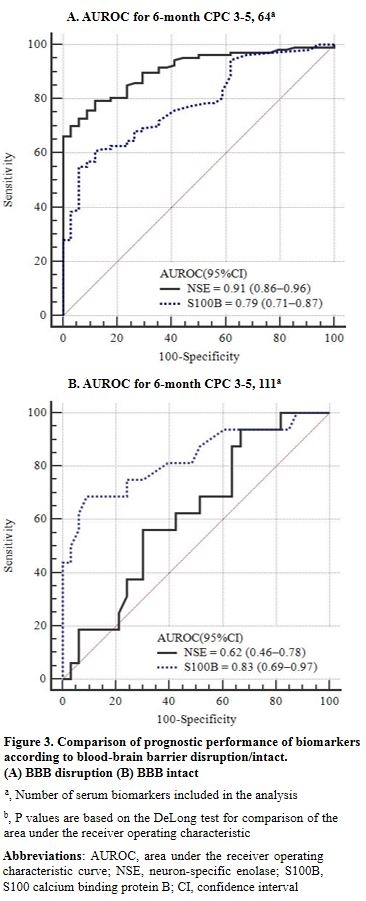Final ID: Sa501
Neurological Prognostication in Cardiac Arrest Survivors: Correlation Between Biomarker Molecular Weight and Blood-Brain Barrier Disruption.
Abstract Body: Aims:This study evaluated the association between blood-brain barrier (BBB) disruption and the molecular weights of biomarkers in predicting neurological outcomes in out-of-hospital cardiac arrest (OHCA) survivors who received targeted temperature management (TTM) and lumbar drainage therapy.
Methods: This observational study used data from a prospectively collected TTM registry at a tertiary academic hospital.Serum levels of neuron-specific enolase (NSE, 47 kDa) and S100 calcium-binding protein B (S100B, 21 kDa) were measured immediately, 24 h, 48 h, and 72 h after return of spontaneous circulation (ROSC). To assess the extent of BBB disruption, the albumin quotient (QA) was calculated at each time point of serum biomarker measurement using the formula: QA = albumin [cerebrospinal fluid] / albumin [serum]. Degrees of BBB disruption were categorized as follows: a QA value less than 0.007 was considered normal; a value within 0.007–0.01 indicated mild disruption; a value within 0.01–0.02 indicated moderate disruption; and a value greater than 0.02 indicated severe disruption. Prognostic performances were evaluated using the areas under receiver operating characteristic curves (AUC). The primary outcome was poor neurological outcome 6 months after ROSC defined as Cerebral Performance Category scores of 3–5.
Results: A total of 562 serum biomarker levels (371 NSE and 191 S100B) in 106 patients (59% poor neurological outcome) were evaluated. Serum levels of NSE and S100B showed no statistically significant difference in prognostic performance for poor neurological outcomes (AUC 0.85 [0.81–0.88] vs. 0.83 [0.80–0.87], P=0.43). Serum NSE levels showed differences in prognostic performance depending on BBB integrity (AUC 0.65 [intact BBB] vs AUC 0.87 [disrupted BBB]), compared with S100B (AUC 0.83 [intact BBB] vs. 0.79 [disrupted BBB]) (Figure 1). In particular, serum NSE levels had higher predictive performance when the BBB was moderately or severe disrupted compared to when it was intact (Figure 2). Additionally, serum NSE levels demonstrated better predictive performance when BBB is disrupted (P< 0.001), whereas serum S100B levels demonstrated better predictive performance when BBB is intact (P = 0.004) (Figure 3).
Conclusions: In this cohort study, the relationship between molecular weights of biomarkers and BBB intact/disruption demonstrated good prognostic performance for OHCA survivors. Prospective multicenter studies are needed to generalize our findings.
Methods: This observational study used data from a prospectively collected TTM registry at a tertiary academic hospital.Serum levels of neuron-specific enolase (NSE, 47 kDa) and S100 calcium-binding protein B (S100B, 21 kDa) were measured immediately, 24 h, 48 h, and 72 h after return of spontaneous circulation (ROSC). To assess the extent of BBB disruption, the albumin quotient (QA) was calculated at each time point of serum biomarker measurement using the formula: QA = albumin [cerebrospinal fluid] / albumin [serum]. Degrees of BBB disruption were categorized as follows: a QA value less than 0.007 was considered normal; a value within 0.007–0.01 indicated mild disruption; a value within 0.01–0.02 indicated moderate disruption; and a value greater than 0.02 indicated severe disruption. Prognostic performances were evaluated using the areas under receiver operating characteristic curves (AUC). The primary outcome was poor neurological outcome 6 months after ROSC defined as Cerebral Performance Category scores of 3–5.
Results: A total of 562 serum biomarker levels (371 NSE and 191 S100B) in 106 patients (59% poor neurological outcome) were evaluated. Serum levels of NSE and S100B showed no statistically significant difference in prognostic performance for poor neurological outcomes (AUC 0.85 [0.81–0.88] vs. 0.83 [0.80–0.87], P=0.43). Serum NSE levels showed differences in prognostic performance depending on BBB integrity (AUC 0.65 [intact BBB] vs AUC 0.87 [disrupted BBB]), compared with S100B (AUC 0.83 [intact BBB] vs. 0.79 [disrupted BBB]) (Figure 1). In particular, serum NSE levels had higher predictive performance when the BBB was moderately or severe disrupted compared to when it was intact (Figure 2). Additionally, serum NSE levels demonstrated better predictive performance when BBB is disrupted (P< 0.001), whereas serum S100B levels demonstrated better predictive performance when BBB is intact (P = 0.004) (Figure 3).
Conclusions: In this cohort study, the relationship between molecular weights of biomarkers and BBB intact/disruption demonstrated good prognostic performance for OHCA survivors. Prospective multicenter studies are needed to generalize our findings.
More abstracts on this topic:
Abdominal Counter-Constriction Versus Abdominal Binding as Hemodynamic Adjuncts to Circumferential Thoracic Cardiopulmonary Resuscitation
Paradis Aidan, Paradis Norman, Gaddy David, Moodie Karen, Mader Timothy, Dufresne Alexandre, Couturier Christine, Dufresne Simon, Davis Daniel, Sims Christopher
Defective autophagy impairs endothelial cells’ function and blood-brain barrier integrity.Mameli Eleonora, Santi Spartaco, Cholewa-waclaw Justyna, Hardingham Giles, Caporali Andrea, Horsburgh Karen, Jansen Maurits, Montagne Axel, Chagnot Audrey, Mccoll Barry, Szymkowiak Stefan, Yau Joyce, Garcia Eva



